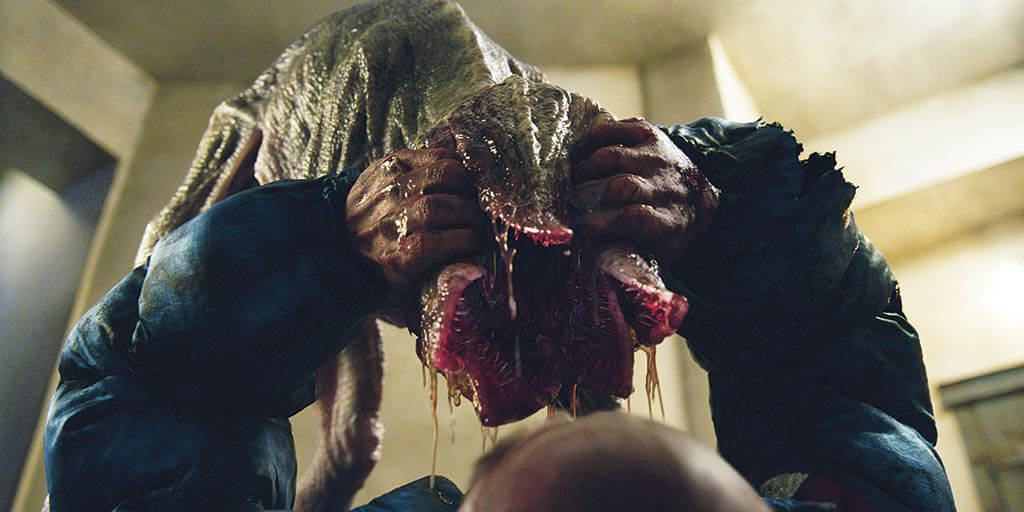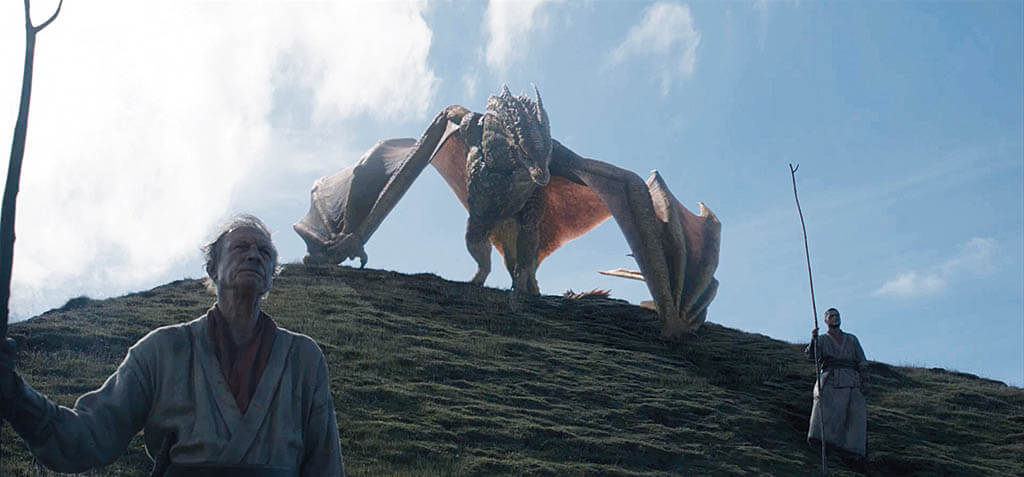By CHRIS McGOWAN
By CHRIS McGOWAN

Digital Domain, which worked on visual effects for the HBO series The Last of Us, seeks to actively listen to client needs, be transparent about capabilities and limitations, deliver on promises, and maintain clear, consistent communications. (Image courtesy of Digital Domain and HBO)
What are some of the successful marketing and production strategies for VFX studios in a time of tremendous pressure to deliver visual effects of ever-increasing quality and demand? How do you differentiate your company and showcase your brand? How do you achieve and maintain profitability in a fiercely competitive and price-driven environment? And how can you meet all those standards while fostering good relationships with clients? Here, several studios weigh in with their opinions about the current state of the VFX business.
MARKETING AND PROMOTION
“A successful marketing and promotion mix for me would revolve around being able to show and talk about our work soon after a project releases,” says Hayley Miller, Pixomondo Group Head of Marketing and Communications. “Catching the buzz of a release is great for our audience engagement and recognition of the teams’ hard work. Fans are increasingly calling out to see VFX breakdowns and behind-the-scenes insights, too; they want to see all the cool and innovative ways we help create the magic they see on screen.”
For VFX vendor studios, effectively marketing and showcasing your capabilities, services and talent roster is crucial, according to Lala Gavgavian, President and COO at Digital Domain. It not only brings visibility to the firm’s offerings, but also highlights its commitment “to collaborating with filmmakers to create visually stunning effects that enhance and serve storytelling,” she notes.
The Third Floor finds success through sharing high quality marketing materials that showcase its storytelling visuals and embrace the latest branding trends, according to Lauren Moore, The Third Floor Chief of Staff. “From press pieces, social media posts, project/technology case studies, newsletters and events, we’re able to create more engagement, which is key to promoting.”

FutureWorks, which worked on this cloaking car effect for The Peripheral, puts their talent front and center when the firm talks about its work so visual artists get the recognition they deserve. (Image courtesy of FutureWorks and Amazon Prime)
“Most of the time it’s about building our reputation and showcasing the quality of work we do,” comments Managing Director Laura Usaite of Vine FX. “The nature of the work is that you have to be trusted by clients to deliver what you promise, so we’re always trying to show what we’re capable of.”
Usaite explains, “Word-of-mouth is still a central part of our process, and we’re working with a marketing and PR agency now to help build our external presence. Our approach isn’t to ‘sell’ what we offer, but instead to show the people we work with the talent we have, and the projects we work on. Let the work speak for itself – industry colleagues don’t need to be told that something is good, they can see it.”
Lux Aeterna prioritizes going to the places its potential clients frequent, from online to industry events. “It gives us the chance to interact with them in the space they play in. Most recently, our Founder and CEO Rob Hifle spoke at the MPTS alongside other key players from the VFX world, which was a great opportunity for us to join in the industry conversation,” says Laura Ashley, Operations & Marketing Manager of Lux Aeterna.
“A successful marketing and promotional campaign for VFX and animation studios in this digital era should be designed around your creative talent, culture and passion for both industry and community, explains Neishaw Ali, Co-Founder, President and Executive Producer of Spin VFX.


Lux Aeterna, which generated galaxies for Netflix’s Our Universe, is based in Bristol, England, and has focused on generating brand awareness since its rebrand at the end of 2022. (Images courtesy of Lux Aterna and Netflix)

Catching the buzz of a release is great for audience engagement and recognition of the Pixomondo team’s hard work. Pixomondo contributed VFX to the Apple+ series See. (Image courtesy of Pixomondo and Apple+)

Important Looking Pirates (ILP), located in Stockholm, worked on this demogorgon for Stranger Things Season 4. As part of its strategy, ILP seeks out the most creative shows to work on and targets VES and Emmy award nominations. (Image courtesy of ILM and Netflix)

For Spin VFX, which worked on the boxing biopic Big George Foreman, a successful marketing and promotional campaign should be designed around the firm’s creative talent, culture, and a passion for both industry and community. (Image courtesy of Spin VFX and Sony Pictures)

A successful marketing and promotion mix for Pixomondo, which worked on this fire-breathing creature from House of the Dragon, revolves around being able to show and talk about its work soon after a project’s release. (Image courtesy of Pixomondo and HBO)
“It’s about the personal stories you share with everyone globally that bring them closer to understanding who you are and what motivates you as a company.”
SHOWCASE YOUR BRAND
“We mainly showcase our work on our social media channels like Facebook, LinkedIn and Twitter and try to spend some time creating nice breakdowns of our projects. We also try to be a part of the most creative shows and create the best work to get nominated to the VES [Awards] and Emmys,” comments Måns Björklund, Executive Producer for Important Looking Pirates (ILP).
It is important to maintain a strong online presence, notes Gavgavian. “Maintaining a professionally designed and regularly updated website is essential. It serves as a platform to showcase the studio’s brand, capabilities and portfolio. Additionally, active social media channels can be leveraged to effectively market and promote the studio’s work and talent base.”
Gavgavian continues, “It is important to showcase completed projects. Distributing company reels that highlight the diversity and quality of visual effects services offered is an effective way to impress potential clients. Including ‘behind the scenes’ breakdowns of specific projects can provide insight into the studio’s approach, the complexity of the work and the final results.”
Usaite adds, “We love to celebrate the work we’ve completed together with the artists that were involved. We always do reels, case studies and behind-the-scenes breakdowns – everything that demonstrates the skills, creativity and technical expertise we have in-house. It’s exciting to be working on big-name projects, and we share that excitement when we promote the successes we’ve had. Industry and local press are crucial to our marketing and PR strategy – getting all coverage we possibly can from print to social media. We want potential clients to see what we’re doing, and future team members as well.”
Since Lux Aeterna’s rebrand (from Burrell Durrant Hifle or BDH) at the end of 2022, the firm’s focus has been generating brand awareness, so it has tailored its promotional activities accordingly. “Our goal currently is to get the new brand out there so that people understand who we are, what we’re great at and why they should work with us. We’re confident that our work does the talking for us, so showcasing our projects has been at the heart of our activities. Social media is an obvious but essential tool, as we can speak to all of our audiences instantly and easily. But as a relatively new brand, we’re focusing on building up our online presence, and PR is a huge driver for this,” Ashley says.
To stand out in a crowd of VFX studios, “ILP is and has always been about the quality of the final image. We always strive to deliver the best possible result, not only in the final product, but also it is important for us to deliver a great service during the production process, making it easy and enjoyable for all involved to work with us,” Björklund says.
“One of our goals is to put the talent front and center when we talk about our work so they get the recognition they deserve and can share with their families and colleagues.
Going beyond just showing before and after comparisons, we seek to highlight the underlying technology and expertise that enables it all,” says Gaurav Gupta, CEO and Founder of FutureWorks.
PRODUCTION STRATEGIES
Spin VFX has a standard production strategy template that all its productions follow. Firstly, Ali says, “Casting of the VFX supervisor and producer is important to ensure that they have previous experience on a similar-type project and that their creative mindsets are likely to mesh with the director and production team.” For artists, it is important that they love the work and are inspired to work on the show, “so we would send out a call to ask who wants to work on the show, or if they know about it.”
Secondly, it is important to establish a development team to create the project’s initial setup immediately upon project award and start breaking down any development tasks to be created and scheduled. Thirdly, Ali notes, “Resourcing is our biggest constraint and needs the most focus. Most times, the hours bid for a project and the actual time spent don’t mesh. When scheduling, it is important to have transparency with the team creating the work.” She adds, “This level requires direct talks, clear understanding of the vision and deadlines to properly schedule based on the artist skillsets and complexity of work, understanding that there will be revisions both internal and external.”
Lastly, comments Ali, “One of the best production strategies that should be considered is the automation in repetitive tasks. Pipeline and rendering are two important departments that are underestimated until the last moment. This creates unnecessary stress on all teams when they should have been considered in the project planning.”
Production strategies will differ depending on how spread out a studio is – a single office, multiple regional offices or a global organization,” notes Gupta. “Different strategies will suit those setups, and it’s rapidly changing as the technology is becoming increasingly real-time, adopting the use of game engines for in-camera VFX and previsualization. At the same time the various project management tools on the market enable a dynamic review system. You can send large amounts of data and reach anyone on the other side of the world very quickly, all of which makes productions more agile and iterative.”
THE WORK ENVIRONMENT
When work is underway, “we do everything we can to create a healthy and creative environment where people share their ideas. Everyone at Vine FX has a voice,” comments Usaite. “Problem-solving becomes easier when you have a talented team that feels empowered to get involved. This not only creates good quality work but also eliminates the stress factor.”
The best production strategies are fueled by connection and communication, according to Liz Montes, The Third Floor Global Head of Production. “At The Third Floor, we listen to our clients’ needs while focusing on our people and our pipeline. We have to enable everyone on the team to collaborate and shine, while removing blockers so that they can be successful.”

For the Netflix film True Spirit, Spin VFX created the boat, water and environmental effects. (Image courtesy of Spin VFX and Netflix)

Spin VFX, which contributed VFX to Ant-Man and the Wasp: Quantumania, focuses on the casting of the VFX supervisor and producer to
ensure that they have previous experience on a similar project and that their creative mindsets mesh with the director and production team. (Image courtesy of Spin VFX and Marvel Studios)


The Third Floor, which worked on effects for Guardians of the Galaxy Vol. 3, prides itself on its unique ability to handle unexpected events, which they refer to as “real-time production calibration.” (Image courtesy The Third Floor and Marvel Studios)
“From press pieces, social media posts, project/technology case studies, newsletters and events, we’re able to create more engagement, which is key to promoting.”
—Lauren Moore, Chief of Staff, The Third Floor

The Third Floor, which contributed VFX to She-Hulk: Attorney at Law, listens to clients’ needs to align them with its own staff and pipeline to enable everyone on the team to collaborate and shine. (Image courtesy of The Third Floor and Marvel Studios)

Cambridge, England-based Vine FX worked on the No Escape series. Their approach isn’t to “sell” what they offer, but instead to showcase the talent they have and the projects they work on. (Image courtesy of Vine FX and Paramount Plus)

Digital Domain, which contributed VFX to Black Panther: Wakanda Forever, believes vendors must showcase their capabilities, services and talent roster, and highlight their commitment to collaborate with filmmakers. (Image courtesy of Digital Domain and Marvel Studios)
Usaite comments, “Listening to your staff is essential, and [so is] knowing what changes or systems you have to implement to help them to get their jobs done. This will further grow the achievable objectives that you set. We have a development system in place to grow our team and support them in becoming more independent. Ownership of a role and a career path is something that’s very important to us, and that will naturally help us to build a stable business with longevity.”
EMBRACING CHANGE
Constant learning and innovation are essential to sustain growth. “It’s normal for things to change, so you have to be flexible,” Usaite says. The COVID-19 pandemic was a challenge, and it was one we rose to. We’d already had a flexible technology infrastructure, so we could adapt quickly. The quicker you adapt, the better the outcomes for everyone. We embrace change and challenge. It’s not something to be frightened of, but [to be] inspired by. Our goal is to continue a steady pace of growth and just deliver good work with a happy, healthy team behind it.”
The Third Floor prides itself on its ability to handle unexpected events with ease. Notes Dane Allan Smith, Chief Strategy Officer at The Third Floor, “I refer to this as real-time production calibration, and it’s something that we take very seriously. Transparency is key in communication, and everyone within our organization is aware of the current and projected volume of business. We also place a great deal of value on company culture, and regularly develop new training programs to ensure that our team is made up of top-tier talent and exemplary leaders.”
“Ours is a dynamic industry, so we make it a point to revisit our strategy regularly and see where we can further optimize our processes and adapt to stay ahead of the curve,” Ashley notes. “We constantly experiment with new ways of working and new pieces of software. Anything that can enable us to push further and produce better results is worth trying in our eyes. At the same time, we make sure that no matter what we’re testing, it never compromises the quality of our work.”
ACHIEVING PROFITABILITY
The VFX industry is known for challenging budgets, intense competition and global adjustments, notes Gavgavian. “While profitability can be challenging, we have evaluated our business plan and made adjustments in various ways,” she says. Another important factor, she continues, is that “investing in more velocity towards achieving highest possible efficiency for workflows also allows the ability to strive [for] and achieve profitability.”
“We believe in transparency and ensure that we’re always being realistic with what we can achieve with the client’s budget and have those honest conversations early on. This in turn builds trust and sets us up for a positive working relationship. Having a production team with years of experience under their belt enables us to run a tight ship, tracking the project throughout so we can proactively course-correct when necessary to avoid problems down the line,” comments Ashley.
“Profitability is not only driven by price, but also solid client relationships, production processes and efficiencies both in talent and innovation that can help you to price competitively,” Ali explains. “We strive not to compete on price, but on creativity, as there will always be someone ready to ‘outbid’. Therefore, if we can compete on creativity and innovation, this is not easily achievable if you’re not already established.”
“The first thing that comes to my mind is honesty. Communication and mutual respect with clients are incredibly important,” Usaite remarks. “Of course, the real key is to make sure that your costs don’t exceed your incomings, which is pretty simple. Don’t over promise, don’t under deliver. Don’t lose money on a project. We try to be open with clients, including in development stages, making sure their expectations are met. We use production management software to help keep us on track and maintain a clear billing cycle, too.”
Gupta says, “It’s always a balancing act with multiple scales involved, from bidding projects to your workflows and team management. Having multiple strategies in place to manage the cost of talent, from acquisition to internal training frameworks and mentorship is one of the pillars for maintaining profitability. At the same time, a robust technological framework is just as necessary to stay efficient with your pipeline. You want to factor in as many variables as possible to keep the production pipeline on track. The more we repeat the same type of work, the more efficient we become, both on the systems level and on the talent side.”
FOSTER CLIENT RELATIONSHIPS
“First, the most important first pillar of any for service business is building strong client relationships,” comments Gavgavian. Developing and maintaining a strong foundation of trust and open communication with studio clients is essential. “Actively listening to client needs, being transparent about capabilities and limitations, delivering on promises and maintaining consistent and clear communication throughout the relationship and project journey are crucial aspects of building successful partnerships,” she notes.
“We started to become well-known for our communication skills,” notes Usaite. “Being nice to everyone involved in the process is really important, as well as the ability to translate information about deadlines and budgets. Reacting in a timely manner to client questions and simply being there for them helps to foster long-term partnerships, which has resulted in a lot of repeat clients for us.” She adds, “Being open, present and kind are the guiding principles we adhere to.”
“We try where possible to help people understand our industry so they can get the best possible results from a VFX team. This helps to get more of the budget on-screen and makes the process a lot smoother for all parties. At Lux Aeterna, we pride ourselves on fostering a creative partnership with our clients – we’re an extension of their team, going on the journey with them from the earliest stages of a project right up to the finish line,” Ashley notes.
“When you have a base level of honesty with clients, staff and industry partners, you can be trusted. It’s building that trust that gives people confidence in what we do, which all leads to ongoing and future success. Be honest and everything else will fall into place,” Usaite advises.
“Our approach isn’t to ‘sell’ what we offer, but instead to show the people we work with the talent we have, and the projects we work on. Let the work speak for itself – industry colleagues don’t need to be told that something is good, they can see it.”
—Laura Usaite, Managing Director, Vine FX



Vine FX, which contributed visual effects to War of the Worlds Season 3, aims to set an active example of how constant learning and innovation are essential to sustain growth. (Image courtesy of Vine VFX and Disney+)

FutureWorks provided all of the color work for the second season of Rocket Boys, the historical drama from Indian streaming platform Sony LIV (Image courtesy of FutureWorks and Sony LIV)